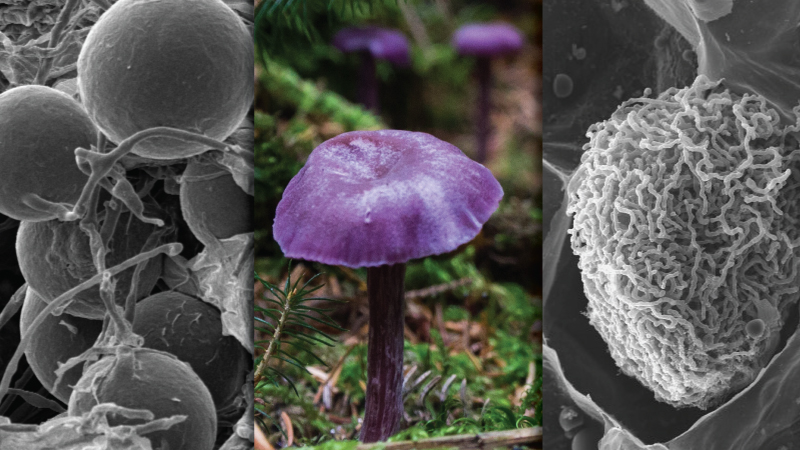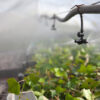
Often one of the initial barriers for a potential user of mycorrhizae is trying to determine what type of mycorrhizae they need for their crop. Do they need Endo, Ecto, Ericoid, Orchid, or some other type of mycorrhizae? Or is the target plant species simply non-mycorrhizal? The lofty objective of this article is to make what seems complicated, simple. And once you know the basics of this process you will be able to start the journey of incorporating mycorrhizae in your horticultural or agronomic operation.
Types of Mycorrhizae
There are seven types of mycorrhizae. *Warning, the further you go down this list you go more into the weeds of what you need to know to use mycorrhizae and the commercial importance of the type of mycorrhizae. It is interesting to know the complete picture, but you only need to know the highlights to become a mycorrhizae user.
Endomycorrhizae – Between 80-85% of all plant species are Endomycorrhizal. This includes basically all greenhouse plants, and most nursery and agronomic crops. The endo- prefix means the mycorrhizae penetrates the plant root cortical cell. Endomycorrhizae are the most common commercially available mycorrhizal type and are included in the majority of the MycoApply products from Mycorrhizal Applications.
Ectomycorrhizae – Between 5-10% of all plant species are Ectomycorrhizal, including most conifers and select hardwood trees. Horticulturally important Ectomycorrhizal plants are mainly included in nursery production, landscaping, and Christmas tree production. The two most important agronomic crops are Hazelnuts and Pecans. The ecto- prefix means the mycorrhizae does not penetrates the plant root cortical cell. However, it does grow between the cells. Ectomycorrhizae are commercially available from a more limited number of suppliers, including MycoApply products from Mycorrhizal Applications.
Ectendomycorrhizae – Are a subset of Ectomycorrhizae. Their plant partner species are confined to the Pinus and Larix genera. The main difference is that in addition to the normal ectomycorrhizal behavior, they also can penetrate the plant root cortical cell with their hyphae. Commercial ectomycorrhizae will work with these types of plants, including the MycoApply products supplied by Mycorrhizal Applications.
Ericoid Mycorrhizae – Only impacts select members of the Ericaceae family. Azalea, Rhododendrons, Pieris, Heath, and Heather are some of the more popular greenhouse and nursery ericoid mycorrhizal plants. Blueberries and Cranberries are the most popular agronomic ericoid crops. Some of the species in the Ericaceae family can also benefit from ectomycorrhizae. There are no effective Ericoid mycorrhizae products commercially available.
Orchid Mycorrhizae – Only impacts members of the Orchidaceae family. The Orchis and Dactylorhiza genera only form mycorrhizal relationships with this specialized type of mycorrhizae. The other genera in the family can sometimes form relationships with Endomycorrhizae. There are no effective Orchid mycorrhizae products commercially available.
Arbutoid Mycorrhizae – Only impacts the genera Arctostaphylos and Arbutus. The Arctostaphylos genus includes manzanitas and bearberries. The Arbutus genus is commonly called Madrones. Some of the species in these genera can also benefit from ectomycorrhizae. There are no effective Arbutoid mycorrhizae products commercially available.
Monotropoid Mycorrhizae – Impacts select hardwood trees and conifers. They are often called ghost plants in that they have no chlorophyll. There are no commercial Monotropoid mycorrhizae available.
Make what Seems Complicated, Simple
To make all of our lives easier Mycorrhizal Applications has recently updated their Mycorrhizal Status of Plant Families and Genera document.
This document is organized by plant family and then by genus within each family. Many common names are also included (but the lists are not exhaustive). The Families and Genera document does not include all members of the Plantae kingdom, but it does cover most commonly (and a lot of uncommon) plants used in horticulture and agriculture. Each genus is then connected with a type of mycorrhizae they associate with. Some genera are connected with more than one type of mycorrhizae.
Non-Mycorrhizal Plants
These independent cowboys in the plant world are a ragtag loosely organized group of plants that can be either variable in their relationship with mycorrhizae (they get no significant benefits from their mycorrhizal associations) or a plant that is highly resistant to forming a relationship with mycorrhizae. About 5% of all plants are considered to be non-mycorrhizal. Many of these plants are what you commonly associate as opportunistic weeds.
| Family | Common Genera | Common Names |
| Aizoaceae | Faucaria | Tiger’s Jaw |
| Amaranthaceae | Amaranthus, Beta, Celosia, Gomphrena, Spinacia | Joyweed, Sugar and Garden Beets, Globe Amaranth, Spinach |
| Brassicaceae | Armoracia, Brassica, Matthiola, Raphanus | Horseradish, Cabbage, Broccoli, Cauliflower, Turnip, Canola, Radish, Stocks |
| Caryophyllaceae | Dianthus, Gypsophilla | Dianthus, Carnation, Baby’s Tears |
| Cleomaceae | Cleome | Spider Flowers |
| Crassulaceae | Sedum (Usually) | Stonecrop |
| Cyperaceae | Carex (Usually) | Sedge |
| Fabaceae | Lupinus (Sometimes) | Lupines |
Now for the Simple
When you decide to move forward with the use of mycorrhizae in your production protocol or in your landscape installation standard practices it is quite easy to make it simple.
Greenhouse Operations – You want to select an Endomycorrhizal product.
Nursery Operations – You have two options – 1) you can select an Endo/Ecto mycorrhizal product or 2) you can select an Endo product for endo plants and an Ecto product for Ecto plants.
Landscape Installations – You want to select an Endo/Ecto mycorrhizal product to keep it simple at the installation site and cover the maximum number of plant types and species.
Here are a couple of other fun facts about mycorrhizal selection and usage:
- It is important to use the rates Mycorrhizal Applications suggests, but there is no such thing as a mycorrhizal application overdose (it cannot hurt your plants). Our suggested dosage rates are based on experience and are a balance between speed of response and cost. If you apply more than is suggested, you could possibly speed up the response. It will cost you more, but you won’t hurt the plant. If you apply too little mycorrhizal inoculant, you will get a response, but it will take longer for both the plant to benefit and for visual differences to be seen by you the grower or landscaper.
- If you apply the “wrong” mycorrhizae to a plant it won’t hurt it. In fact, it could help it, but not significantly. A more careful examination of the Family and Genera list also shows that some plants form relationships with more than one type of mycorrhizae.
I hope my objective was achieved. That what you thought was complicated, is actually simple when you review and understand the available information. Over 90% of all plants can benefit from developing relationships with the commercially available Endo- and Ectomycorrhizae. It is now time to put those microscopic organisms to work.
If you have any questions about anything covered in this article, please contact your local Mycorrhizal Applications Representative or call 866-476-7800 or email us at inquiries@mycorrhizae.com.
Article by: Blair Busenbark
Mycorrhizal Applications – Sales & Commercial Marketing Manager
May 19, 2020






